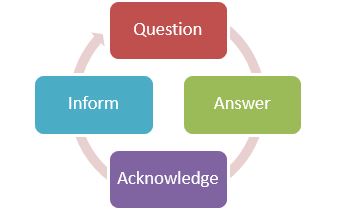If you’re in the business of giving mortgage advice, you know that it’s tightly regulated to ensure the customer is advised on the most appropriate solution based upon their needs. And that’s the absolutely right thing to do.
The consequence is a torrid experience for the poor old customer. Not all, but a good 50% of mortgage factfinds are stifling, scripted and interrogative
The problem is that firms and individuals who are tasked with this “advice risk” don’t want to get it wrong and be sued later with a visit from the Financial Ombudsman Service. So they’ve tightened the process almost to the extent of scripting questions to ask.
The consequence is a torrid experience for the poor old customer. Not all, but a good 50% of mortgage factfinds are stifling, scripted and interrogative. I kid you not. They’ve been structured by risk averse compliance people, and they truly are interviews. The irony is that they don’t have to be so.
This article will show you how you can elicit identified needs to be able to produce a solid recommendation for the right mortgage and give the customer a really enlightening and enjoyable experience whilst doing so. It’s the best of both worlds.
Hard Fact Conversation
Factfinding consists of a number of areas. A whole lot of hard facts about the customer and then softer information which comprises criteria and preferences. We’ll start with the pure facts.
These are pretty straightforward to obtain. Most factfinds contain boxes for which you ask the appropriate question and then you fill them in. These are great on a screen because they’re used to populate your advice system, application forms and suitability reports, so it saves a whole lotta time.
We want a conversation, not an interrogation or question and answer session. Many advisers are taught open versus closed and sugar coating techniques to ask more pleasant questions and have first class listening and empathy skills to keep the customer talking, but it’s still a question and answer session, albeit an agreeable one.
To create a true conversation you need to use my Conversation Cycle technique. Allow me to explain.
The Conversation Cycle
A typical questioning session involves person A asking the question, person B answering it, person A following up with another question and person B answering. Nothing wrong with that approach but it isn’t a conversation. Conversations swing back and forth and can continue for ages. Let’s mash this up a bit.
Person A still asks a question and you can do all the sugar coating and softening you like with this question, make it a high gain, curious open question if you want, and person B still answers it. But this time person A does some form of acknowledging to encourage more response from person B.
This can be:
A verbal nod such as “I see”, “That’s fascinating”, or “Keep going”.
An empathy statement which shows you’ve experienced just the same thing. A “me too” moment. For example, person B might answer the question about their holiday in Florida when they swam with the dolphins. Person A would empathise with “We holidayed in Florida last year and the weather was fantastic but we didn’t get to that theme park. It sounds fun.”
A reflective statement such as “Swimming with dolphins must have been an amazing experience”.
Now these acknowledgements turn things around immensely. The aim is to allow person B to carry on talking and conversation can ensue quite quickly. But let me finish off the cycle in style for you and add a fourth element.
So person A asks a question, person B is kind enough to respond, person A then throws in an acknowledgement, person B doesn’t respond, so person A throws in an “inform”.
An “inform” is merely a statement, a precursor to another question. Some new context in order to launch the next phase of the conversation. It allows you to steer the conversation in the direction you seek. For example, following our dolphin story.
Person A might acknowledge and say how fascinating that must have been and might add, “Holidays are an important expenditure for us all, and many clients spend a fair proportion of their disposable income on leisure and holidays”.
That’s the inform – the context to launch another question such as “What proportion of your disposable income do you like to allocate to leisure activities?”
So that’s the cycle:
And you can go back and forth, sideways, around the cycle…there are no rules on that, just enjoy a good conversation rather than an interrogation.
Back to Hard Facts
If we apply this technique to gathering hard facts, you can see how it begins to work. Let’s role-play the part when the mortgage adviser gathers information about the customer’s current job role.
“Let’s get into the subject of your current job, Mr Khan, if that’s OK? Tell me about where you currently work?”
As the customer speaks, our adviser, who is Inside Sales, uses verbal nods. “OK, I’m with you, that sounds interesting, I bet that’s difficult” and so on.
The customer gives more information and the adviser populates his factfind as the customer speaks, because he’s good at that. The customer stops talking.
Our adviser comes in with an “inform”. “Your company sounds large enough to have a good company pension scheme. Could you please shed some light on that?”
And the customer continues and mentions his retirement date set by his scheme.
“Ah, so retiring at aged 65 means you can put your feet up once and for all. How important is that to have all your debts paid off by then, including your mortgage?”
We’ve now picked up on some criteria information so we’re testing it to see if we can arrive at some identified needs for the mortgage term.
The moral here is if you are merely gathering hard facts, listen out for clues which can help you also gather soft criteria and needs as well.
Soft Facts and Mortgage Criteria
Now we step into the mortgage needs section to elicit the criteria or identified needs to be able to give advice. There’s several need areas that advisers ask – term of the loan, budget, risk nature of the mortgage, concerns over interest rates and so on.
Use the conversation cycle in exactly the same way. Let’s hit on the term issue again.
Advisers starts with “The State Retirement Age is currently 68 for you Mr Khan. When were you thinking of giving up work?” The customer talks. The adviser continues “That’s exciting for you. I’ve got over 30 years before I can stop work unless they bring in robots to do my job. Many of our customers like to have their mortgages repaid as quickly as possible. Where do you stand on this?”
Mr Khan gives information that he wants it paid off as quickly as possible. So the adviser comes in with, “Paying the mortgage off early sounds like a fab goal Mr Khan, but what budget were you looking at putting on the mortgage payments for you to be able to pay it off as soon as you can?”
This will now give you the identified needs to recommend a term.
Let’s now take a look at a risk and mortgage repayment method. “Mr Khan, there are broadly two ways in which you can arrange payments on your mortgage. How aware are you of these two methods?” Mr Khan is unsure. “Would you like me to explain them?” And he does. “Which do you find you’re pointing towards?” Mr Khan likes the capital and interest. “Yes, capital and interest is popular because you’re certain to repay the mortgage at the end of the term and there’s no surprises. So the certainty of paying is important, is that right Mr Khan?”
“Certainty of repaying the loan is one thing Mr Khan, and this can also relate to the interest rate on your mortgage which can impact your attitude as well. There’s a variety or mortgage interest types we have available, have you done any research on these?” Mr Khan says he’s looked at the fixed rate and likes this. “Yes, fixed rate mortgages have many advantages over the others. May I ask Mr Khan, what’s steered you towards these?” And he tells you he likes to have control and know his payments, it lets him budget. “I applaud you for that, it’s so important to have control over your finances especially when your home is at risk. Mr Khan, am I hearing that control and stability is vital for you here? ”
And bingo, you have an another identified need for a mortgage with bullet proof evidence why Mr Khan is suitable for that. Another way to do the mortgage type piece is to come in and inform him of the various types.
“Mr Khan, you’re aware I’m sure that we have lots of different types of mortgage on offer here at ABC Bank. How familiar with them are you?” “That’s fine, lots of my customers like me to explain them, will you let me do that for you? ” So the adviser explains the different types. And every now and then, pauses and asks for Mr Khan’s feelings on it. “So how do they sound so far, what do you like about them so far?”
At the end of the explanation, “Give me your thoughts please Mr Khan?”
“I see, fixed sounds good. Do you mind me asking exactly why?”
And bingo, you have an identified need all within a jolly enjoyable conversation.
Budget again. “Mr Khan, I recall that you like to have a firm grip on your finances. Lots of customers have a budget in mind which they don’t want to exceed. Where do you stand on this?”
And you continue in the same vein.
Believe me, no animals or humans were injured in the making of this movie.





